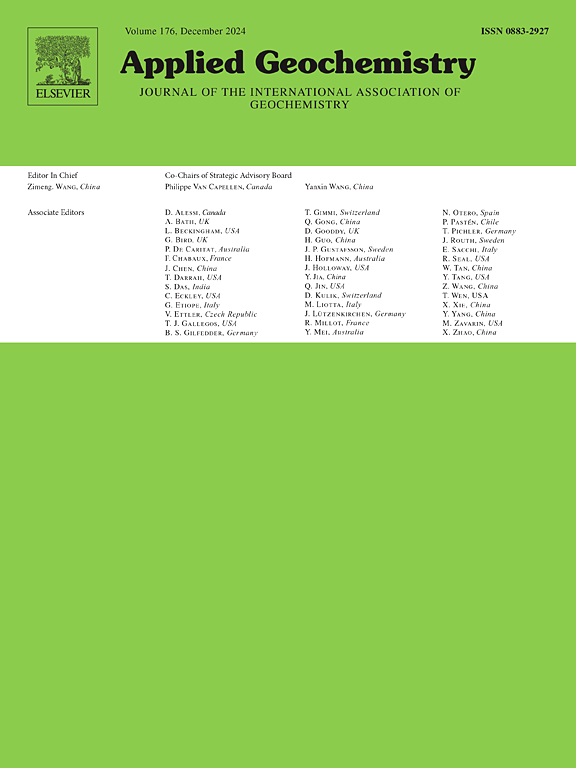Rock weathering characteristics and carbon sink in the Liujiang Basin, North China
IF 3.4
3区 地球科学
Q1 GEOCHEMISTRY & GEOPHYSICS
引用次数: 0
Abstract
Global greenhouse gas emissions are on the rise, exacerbating warming. Rock weathering significantly influences the carbon cycle and climate. There are differences in the consumption of atmospheric CO2 during the weathering process of different rocks. The Liujiang Basin, typical strata from various geological periods in North China, holds significant representative importance in assessing rock weathering and carbon sink. In this regard, we collected two sample series during both high-water and low-water periods and assessed the chemical weathering rates based on the chemical and isotopic compositions of the water, as well as a forward modeling strategy which is based on mass balance. The forward modeling analysis illustrated that rock weathering contributed the most to the total cations (81.62 %–97.13 %, with an average of 92.89 %), with carbonate rock weathering contributing the most (23.80 %–77.12 %, with an average of 54.61 %), followed by silicate rock weathering (3.27 %–61.19 %, with an average of 21.17 %) and evaporite dissolution (5.93 %–26.52 %, with an average of 17.11 %). The Sr concentrations in the river water ranged from 0.63 to 21.34 μmol L−1, while Sr isotope ratios (87Sr/86Sr) had a 101 % variation scale. The δ13C values ranged from −14.73 to −7.06 ‰. Quantitative analysis further illustrated that atmospheric precipitation, carbonate, and evaporite inputs collectively accounted for 64.15 % (42.12 %–97.61 %) of total dissolved Sr, while silicate rocks accounted for 35.85 % (2.39 %–57.88 %). Overall, the silicate and carbonate weathering rates in the Liujiang Basin were 6.35 t km−2·a−1 and 22.20 t km−2·a−1, respectively. The atmospheric CO2 consumption flux from silicate and carbonate weathering was 2.27 × 105 mol km−2·a−1 and 2.56 × 105 mol km−2·a−1, respectively. Considering plant biomass management, the carbon sinks of silicate and carbonate rocks in the Liujiang Basin can increase by about 27 % and 4 %. The rock weathering CO2 consumption flux in the Liujiang Basin matches or exceeds other major Chinese rivers, highlighting the importance of small watersheds in carbon sequestration.

柳江盆地岩石风化特征与碳汇
全球温室气体排放量正在上升,加剧了气候变暖。岩石风化对碳循环和气候有显著影响。不同岩石在风化过程中对大气CO2的消耗是不同的。柳江盆地是华北地区各地质时期的典型地层,在岩石风化和碳汇评价中具有重要的代表性意义。为此,我们收集了高水位和低水位的两个样品系列,并基于水的化学和同位素组成评估了化学风化速率,以及基于质量平衡的正演模拟策略。正演分析表明,岩石风化作用对总阳离子的贡献最大(81.62% ~ 97.13%,平均92.89%),碳酸盐岩风化作用贡献最大(23.80% ~ 77.12%,平均54.61%),硅酸盐风化作用(3.27% ~ 61.19%,平均21.17%)、蒸发岩溶蚀作用(5.93% ~ 26.52%,平均17.11%)次之。河中Sr浓度范围为0.63 ~ 21.34 μmol L−1,Sr同位素比值(87Sr/86Sr)变化幅度为101%。δ13C值为- 14.73 ~ - 7.06‰。定量分析进一步表明,大气降水、碳酸盐和蒸发岩输入合计占总溶解Sr的64.15%(42.12% ~ 97.61%),硅酸盐岩石占35.85%(2.39% ~ 57.88%)。总体而言,柳江盆地的硅酸盐和碳酸盐风化速率分别为6.35 t km−2·a−1和22.20 t km−2·a−1。硅酸盐和碳酸盐风化作用的大气CO2消耗通量分别为2.27 × 105 mol km−2·a−1和2.56 × 105 mol km−2·a−1。考虑植物生物量管理,柳江盆地硅酸盐岩和碳酸盐岩碳汇可分别增加27%和4%左右。柳江流域岩石风化CO2消耗通量与中国其他主要河流相当或超过,凸显了小流域在固碳中的重要性。
本文章由计算机程序翻译,如有差异,请以英文原文为准。
求助全文
约1分钟内获得全文
求助全文
来源期刊

Applied Geochemistry
地学-地球化学与地球物理
CiteScore
6.10
自引率
8.80%
发文量
272
审稿时长
65 days
期刊介绍:
Applied Geochemistry is an international journal devoted to publication of original research papers, rapid research communications and selected review papers in geochemistry and urban geochemistry which have some practical application to an aspect of human endeavour, such as the preservation of the environment, health, waste disposal and the search for resources. Papers on applications of inorganic, organic and isotope geochemistry and geochemical processes are therefore welcome provided they meet the main criterion. Spatial and temporal monitoring case studies are only of interest to our international readership if they present new ideas of broad application.
Topics covered include: (1) Environmental geochemistry (including natural and anthropogenic aspects, and protection and remediation strategies); (2) Hydrogeochemistry (surface and groundwater); (3) Medical (urban) geochemistry; (4) The search for energy resources (in particular unconventional oil and gas or emerging metal resources); (5) Energy exploitation (in particular geothermal energy and CCS); (6) Upgrading of energy and mineral resources where there is a direct geochemical application; and (7) Waste disposal, including nuclear waste disposal.
 求助内容:
求助内容: 应助结果提醒方式:
应助结果提醒方式:


